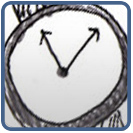The most common question that creative people get asked by “normal” people may well be, “Where do you get your ideas?” It’s a difficult question to answer, because it assumes there is an easy answer, some kind of tangible oasis that transforms visitors into brilliant artists. In my experience, ideas for comics (and other art forms) aren’t found in one place, but in EVERY place. And if one wants to be a creator, then one should constantly be seeking out new experiences in life and art alike, actively seeking inspiration instead of expecting it to arrive.
[Tweet “Ideas for comics aren’t found in one place, but in EVERY place.”]










